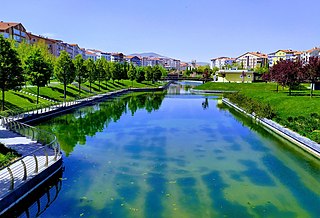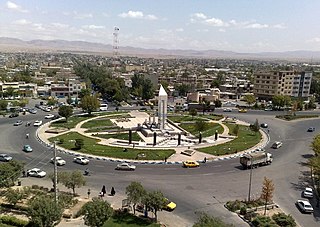

Darakeh is an area in District 2 of Tehran province in Iran. [1] It is near Evin and Velenjak.
The area is popular with tourists as a hiking and mountain climbing destination, [2] and is also the site of numerous seismic fault zones. [1]


Darakeh is an area in District 2 of Tehran province in Iran. [1] It is near Evin and Velenjak.
The area is popular with tourists as a hiking and mountain climbing destination, [2] and is also the site of numerous seismic fault zones. [1]

Tehran province is one of the 31 provinces of Iran. Its capital is the city of Tehran. It covers an area of 18,814 square kilometres (7,264 sq mi) and is located to the north of the central plateau of Iran.

Ramsar is a city in the Central District of Ramsar County, Mazandaran province, Iran, serving as capital of both the county and the district.

Kırşehir Province is a province in central Turkey, forming part of the Central Anatolia Region. Its area is 6,584 km2, and its population is 244,519 (2022). It stands on the North Anatolian Fault, and is currently in an earthquake warning zone. The average elevation is approximately 985 meters above sea level. The provincial capital is Kırşehir. The geographical centre of all land surfaces on Earth is at 39°00′N34°00′E, in Kırşehir Province, Turkey.
An earthquake affected several villages in the Kerman province of Iran on February 22, 2005, at 05:55:23 local time. The shock measured 6.4 on the moment magnitude scale and had a maximum Mercalli intensity of VIII (Severe). Zarand is located 740 km southeast of Tehran. The maximum recorded peak ground acceleration was 0.51 g at Shirinrud dam. The United States' National Earthquake Information Center and the Belgian' Centre for Research on the Epidemiology of Disasters both show that 612 died and 1,411 were injured in the event.

Quchan is a city in the Central District of Quchan County, Razavi Khorasan province, Iran, serving as capital of both the county and the district. It is approximately 97 km south of the border city of Ashgabat, capital city of neighboring Turkmenistan.

Evin is a neighbourhood in the north of Tehran.

Greater Tehran Metropolitan Area is the urban agglomeration around Tehran that covers the central part of the Tehran Province and eastern part of the Alborz Province, that covers the contiguous cities of Tehran, Ray, Shemirānāt, and other areas.

Yervandashat is a village in the Armavir Province of Armenia. The village has a ruined basilica dated to the 4th or 5th century and the Saint Shushanik church of the 10th to 17th century. Along the main highway leading to and from the area are khachkar monuments. It is named after the nearby Armenian historic city of Yervandashat.
The 1962 Buin Zahra earthquake occurred on September 1 in the area of Buin Zahra, Qazvin Province, Iran. The shock had a Richter magnitude of 7.1 and resulted in 12,225 fatalities. Qazvin Province lies in an area of Iran that experiences large earthquakes. The 1962 event originated on one of many faults in the area, called the Ipak Fault. The fault is believed to have been reactivated multiple times.
The 1909 Borujerd earthquake also known as Silakhor earthquake occurred in Silakhor plain, Persia on January 23. Around 8,000 fatalities were caused directly from the magnitude 7.3 earthquake. An indefinite number of aftershocks continued for six months after the main shock. The section on this fault ruptured was the same as the main rupture zone of the 2006 Borujerd earthquake.
Duzduzan is a city in Mehraban District of Sarab County, East Azerbaijan province, Iran.

The 856 Damghan earthquake or the 856 Qumis earthquake occurred on 22 December 856. The earthquake had an estimated magnitude of 7.9, and a maximum intensity of X (Extreme) on the Mercalli intensity scale. The meizoseismal area extended for about 350 kilometres (220 mi) along the southern edge of the eastern Alborz mountains of present-day Iran including parts of Tabaristan and Gorgan. The earthquake's epicenter is estimated to be close to the city of Damghan, which was then the capital of the Persian province of Qumis. It caused approximately 200,000 deaths and is listed by the USGS as the sixth deadliest earthquake in recorded history. This death toll has been debated.
The 1893 Quchan earthquake occurred at about 19:30 local time on 17 November. It had an estimated magnitude of 6.6 on the surface wave magnitude scale and a maximum perceived intensity of IX (Violent) on the Mercalli intensity scale. It caused severe damage in Quchan County, particularly to the town of Quchan itself and there were an estimated 18,000 casualties.
The 1979 Ghaenat earthquakes were a series of large earthquakes in Qaen County, Khorasan Province, northeast Iran, near the Afghanistan border. The first mainshock, known as the Korizan earthquake with a surface wave magnitude (Ms ) of 6.6 and moment magnitude (Mw ) of 6.8, struck on November 14, while the Ms 7.1 or Mw 7.2 Koli-Boniabad earthquake struck on November 27. The two mainshocks were assigned a maximum Modified Mercalli intensity of VIII (Severe) and X (Extreme), respectively. The earthquakes caused extensive damage throughout northeastern Iran, killing an estimated 297 to 440 people and left at least 279 injured.
The 1944 Gulf of Edremit–Ayvacik earthquake occurred on October 6 at 05:34:48 local time in Balıkesir Province, Turkey. It measured 6.7 on the moment magnitude scale (Mw ) and occurred at a depth of 15 km (9 mi). The normal-faulting event had a maximum MSK-64 intensity of IX. A total of 73 people died and 275 others were injured.
The 1997 Bojnurd earthquake occurred on 4 February at 14:07 IRST in Iran. The epicenter of the Mw 6.5 earthquake was in the Kopet Dag mountains of North Khorasan, near the Iran–Turkmenistan border, about 579 km (360 mi) northeast of Tehran. The earthquake is characterized by shallow strike-slip faulting in a zone of active faults. Seismic activity is present as the Kopet Dag is actively accommodating tectonics through faulting. The earthquake left 88 dead, 1,948 injured, and affected 173 villages, including four which were destroyed. Damage also occurred in Shirvan and Bojnord counties. The total cost of damage was estimated to be over US$ 30 million.
The 1977 Bob–Tangol earthquake struck Kerman province of Iran on December 20, 1977 at 03:04 Iran Standard Time. The earthquake measured Mw 5.9 and struck at a depth of 22.7 km (14.1 mi). A maximum Modified Mercalli intensity of VII was evaluated based on damage. It had a strike-slip focal mechanism, which was unusual as the source structure was a thrust fault. It was part of a sequence of strong earthquakes along the 400 km (250 mi) Kuh Banan Fault. Between 584 and 665 people perished while a further 500–1,000 were injured; thousands were also made homeless. Casualties from the earthquake was considered moderate due to the sparsely populated area it affected. Preceded by foreshocks the month before, many residents became wary of a larger earthquake and took refuge outside their homes, contributing to the moderate death toll. However, there were none immediately before the mainshock so many were still in their homes when it struck. Aftershocks were felt for several months, some causing additional damage.
The 1977 Khurgu earthquake struck southern Iran near Bandar Abbas in Hormozgan province on the morning of March 22. The earthquake measuring moment magnitude (Mw ) 6.7 struck at a depth of 12.5 km (7.8 mi). Thirty five villages were heavily damaged including over 20 which were destroyed. There were 152–167 people killed and 556 injured.
The 1957 Sangchal earthquake struck northern Iran's Mazandaran province on 2 July 1957. It had a moment magnitude of 6.6 or 7.1 (Mw ), focal depth of 15 km (9.3 mi), and maximum Modified Mercalli intensity of IX (Violent). It devastated many communities in the Alborz Mountains and caused an estimated 1,500 fatalities. Damage was estimated at US$25 million.
34°26′54″N47°40′15″E / 34.44833°N 47.67083°E